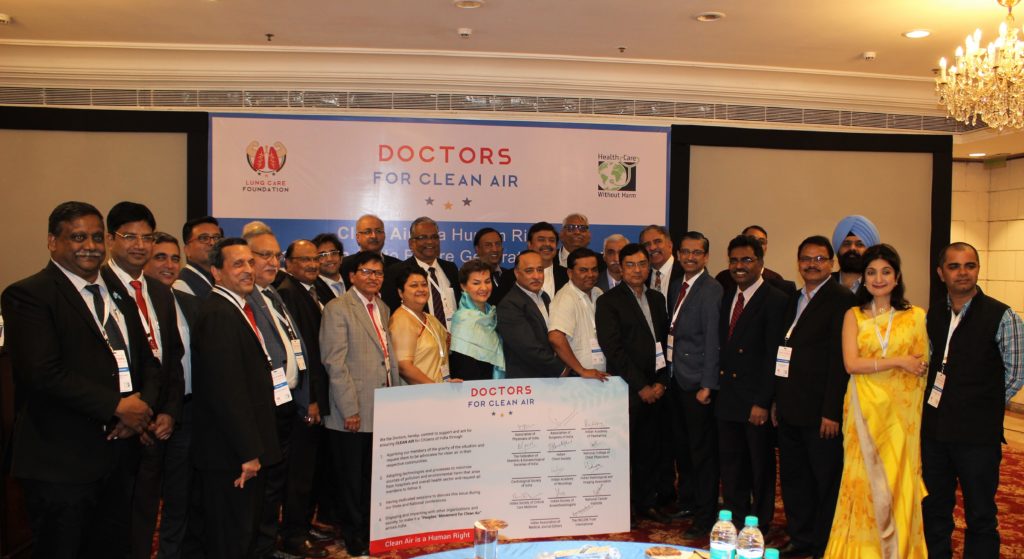Mrs Simran Kaur showed up at Dr Arvind Kumar’s hospital in the city of Delhi complaining of a lump in her neck.
The 34-year-old housewife and mum of three had never smoked, and neither had her husband, so the test results were a shock, even to Dr Kumar: she had Stage 4 lung cancer.
“She was going to die no matter what you did,” recalled Dr Kumar, addressing a high-level audience at the first WHO Global Conference on Air Pollution and Health last month.
Mrs Kaur’s tragic story was part of a growing trend that signalled the danger of rising air pollution in the city of New Delhi to the thoracic (chest) surgeon of 30 years, who manages the largest chest surgery department in India that treats over 1,000 chest patients each year.
“When I first started operating in 1998, I would see mostly smokers— 80 to 90 per cent of these cases would be smokers— and if we saw a patient who was a non-smoker, we would wonder why this person had cancer,” he said, “so we would equate lung cancer with smoking.”
But, in the last seven or eight years, the doctor and his team started noticing that distribution was changing: they were seeing as many non-smokers as they were smokers.
“The child born in New Delhi inhales about 15 cigarettes on the first day of his life”
There were other disturbing trends.
For one thing, his patients were getting younger.
“I have many patients in their 30s and 40s. Before, exposure would start at, say, 20 years of age, when you would start smoking, but, today, the exposure starts from the first breath of your life,” Dr Kumar explained.
“So, the child who is born in the city of New Delhi, going by the air quality today, on the first day of his life will inhale about 15 cigarettes,” he said.
“There were very few (woman) lung cancer patients earlier, but now, nearly 40 per cent of my patients are women,” he said.
He drew the link with the air pollution in New Delhi, which has become infamous for its sheer, smoggy intensity, particularly in November when huge swathes of crop stubble are burnt to quickly accommodate a new crop growing cycle.
Doctors: A new force for clean air
The observations coaxed Dr Kumar out of the operating theatre and into public advocacy for better air quality, reaching tens of thousands of children in India through his Lung Care Foundation.
Today, doctors from every state in India and 14 National Associations representing 150,000 medical specialists joined Dr Kumar in the launch of Doctors for Clean Air, at an event that was also attended by former UN Climate Change Convention Executive Secretary Christiana Figueres.
Dr Kumar’s vision is for Doctors for Clean Air to be network of doctors across India— including surgeons, physicians, pulmonologists and paediatricians— passionate about clean air and working towards it by highlighting the ill health effects of air pollution and supporting various groups working on air pollution.

Launch of Doctors For Clean Air. Photo by Lung Care Foundation
The new organization joins a formidable, ascending force: doctors and other healthcare practitioners around the world, dealing with the bulk of the hidden costs of air pollution in their hospitals, are banding together to tackle air pollution and its effects on human health.
“That’s why air pollution is our fight too, because people are dying and getting sick from diseases caused by air pollution,” said WHO Director, Public Health, Environmental and Social Determinants of Health, Dr Maria Neira, addressing the event.
“It is our fight because we are the ones patients trust to help them safeguard their health and the ones they turn to for advice— this trust comes with great responsibility, and we can’t renege on that,” she said.
“We are the best advocates for preventive action for better health outcomes, and it is clear that cutting air pollution is part of preventive action where non-communicable diseases is concerned,” said Dr Neira.
That advocacy is going strong and growing: a recent commentary in the British Medical Journal indicated that air pollution is rising in the health agenda, an observation backed up by a major Lancet report released last week, which showed that coverage of the health implications of climate change— including where they intersected with air pollution— has increased dramatically in scientific journals.
Groups representing thousands of current and future doctors and healthcare workers— including Médecins du Monde, Healthcare Without Harm, the Global Climate and Health Alliance, Health and Environment Alliance and the International Federation of Medical Students Associations— took the floor at the World Health Organization Global Conference on Air Pollution and Health to declare commitments that would contribute to improving air quality around the world.
While it may be an unfortunate poster child for harmful air, New Delhi is hardly alone: the Lancet report found that people in 90 per cent of the world’s cities breathe polluted air that is toxic to their cardiovascular and respiratory health. Seven million people died in 2016 from diseases caused by air pollution– 600,000 of them were children.